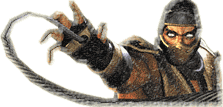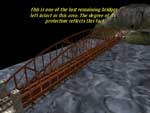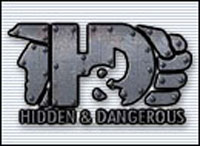|
|
||||||||||||||
  
A good challenge Excellent strategy elements Quite high difficulty Missions can take a long time
The game plays like you would expect any moderately realistic World War II shooter would. You control one member of your squad at a time and with this operative you can issue orders, shoot, use items etc. to your heart's content. Your missions usually consist of either rescuing something or blowing something up, whilst at the same time avoiding or taking down the guards. This is easier said than done, as whilst your own soldiers have pretty good AI, your enemies can still inflict a hefty amount of damage on them with ease. It's only when the command screen is entered that the game changes from a generic, although very well made, action game to a brilliant strategy game too. You can issue a very large variety of orders in this screen, which still take effect if you swap to one of the soldiers. This can be very, very useful if you don't know where to go, as you can interrupt your movement to shoot or change your pose if you need to.
Once an operative is dead, they are gone forever. For that reason, in the first couple of campaigns I took operatives with middling statistics in pretty much every field, although I wanted the AI-controlled operatives to have a high standard of reactions, so that they would adapt quickly to whatever was thrown at them, as opposed to letting enemies by. There are a few statistics, including accuracy, stealth and strength. Each of the statistics are fairly self-explanatory, and picking soldiers with a low endurance will probably result in their deaths, truth be told. Another good point is the equipment selection. At the start of a campaign, you are offered up a huge arsenal of weapons to pick from, and you are given a certain weight allowance. This means that your equipment selection needs to be quite balanced and more than eight weapons (one for each of your operatives) should really be taken, with losses in the field being pretty common.
That said, one of the other good points in the game is the scavenging element. As you move through the battlefields of the game all of your foes' equipment can be picked up. For this reason, I picked the two soldiers the most capable of carrying large amounts of weight. At the end of the first campaign, I had amassed a huge number of stick grenades, MP-40s and also rifles, and plenty of ammunition for them. The graphics are pretty good and there is very little 'voice achtung' (rubbish German stereotypical voice-acting). There isn't much music, but the music that's there's fairly good. Each of the missions also has a fully voiced (and subtitled) briefing, which tells you pretty much exactly what your objectives are as well as the better ways to achieve them, and also shows where enemy patrols are. That said, there are a fair few problems with the game, which vary from being annoying to those that will make you quit to the desktop in frustration. One of the main problems with Hidden & Dangerous is its difficulty. To be honest, it starts off quite easily; the first mission should be a breeze unless you rush into it. The second mission isn't too bad either. After this, though, the game gets much, much harder. A great deal of the game after the first couple of missions relies on planning your mission out in your head before doing it. In the first campaign, improvisation is practically encouraged. In the second campaign and onwards, the player's skill is rewarded, but so is their forethought. Another problem is the way in which vehicles are implemented. To me, they seem like a bit of an afterthought, but I might just be cynical. Not only are most of them horrendously buggy, they are also mostly tedious to use. The 'tank' (die-hards would call it an assault gun as it has no turret) is pretty fun to use for about twenty seconds, after which the player realises that the developer might as well have just made hunting down tanks with bazookas a mission objective instead of giving the player a tank to use. It would have been much more in-keeping with the spirit of the game, too.
Next come the bugs. At the first release the game was, frankly, unplayable. Multiple patches later and it's finally approaching a stage in which the bugs are still pretty bad, but as long as the player remembers to save pretty much only when necessary (if they are required to leave their computer for a while, for example) then they should be alright. Still, some of them do range right up to crashing to desktop at times, with no apparent reason. That kind of thing is what lead me to stop playing the game for a fairly extensive amount of time. So, to sum it all up, the game is an excellent one, but it also has some pretty bad flaws. The idea is quite a good one and the strategy elements inject some much-needed variety into the game. I'm going to award it 3.9 on the basis that the gameplay is excellent, the graphics are pretty good, especially by freeware standards, and the sounds aren't too bad. The negative points are the bugs, the difficulty and also the problems involved with equipment selection. Review by: PrejudiceSucks
 More screenshots 3.9
Rock on! (45 posts) 259 MB
Blood, Violence
Safe for ages: 13+ CPU; 400 MHz.
3D graphics card; 16MB memory, 64 MB of ram, Direct X 8.1
|

 Hidden and Dangerous. Some people think it's a work of pure genius, others will slate it for the (frankly terrible) bugs. It's a game about the SAS and their role in World War II. You control a squad of up to four SAS operatives from a pool of eight which you have to choose for any given campaign. This squad can be changed between missions, as can their equipment, but once you're in a mission, that's it - you have to make do with your equipment and what you can scavenge.
Hidden and Dangerous. Some people think it's a work of pure genius, others will slate it for the (frankly terrible) bugs. It's a game about the SAS and their role in World War II. You control a squad of up to four SAS operatives from a pool of eight which you have to choose for any given campaign. This squad can be changed between missions, as can their equipment, but once you're in a mission, that's it - you have to make do with your equipment and what you can scavenge. At the start of the game, there is a very, very large pool of operatives for you to pick from. Quite a lot of them have 'stand-out' statistics, like having 100% accuracy, but those soldiers are amazingly valuable and losing them is a big blow. That said, if you give them a sniper rifle and leave them in the AI's capable hands then they will hit with every round. Most of the soldiers have statistics which are between sixty and eighty percent each. These soldiers are just as good when the player controls them (or so it seems, there may be small differences) but are less skilled when left to their own devices.
At the start of the game, there is a very, very large pool of operatives for you to pick from. Quite a lot of them have 'stand-out' statistics, like having 100% accuracy, but those soldiers are amazingly valuable and losing them is a big blow. That said, if you give them a sniper rifle and leave them in the AI's capable hands then they will hit with every round. Most of the soldiers have statistics which are between sixty and eighty percent each. These soldiers are just as good when the player controls them (or so it seems, there may be small differences) but are less skilled when left to their own devices. The weapons at your disposal range from small pistols to bazookas and anti-tank mines and everything in between. There are plenty of rifles and sub-machine guns to arm your standard operatives with and those with high reactions and accuracy might do well with a light machine gun too, the choice is entirely the player's. There is also, excellently, a camera which saves the images to your hard-drive. If you want a lot of images then you'll have to take a lot of cameras with you, though, and they each only have one use.
The weapons at your disposal range from small pistols to bazookas and anti-tank mines and everything in between. There are plenty of rifles and sub-machine guns to arm your standard operatives with and those with high reactions and accuracy might do well with a light machine gun too, the choice is entirely the player's. There is also, excellently, a camera which saves the images to your hard-drive. If you want a lot of images then you'll have to take a lot of cameras with you, though, and they each only have one use. This leads me onto another problem. Unless you let the computer automatically pick your equipment for your campaign, which takes a lot of the fun out of the game, you can often end up without critical equipment for your whole campaign. This is a huge problem when you get to the last mission of a campaign only to realise then that you needed to bring anti-tank mines, a few cameras and also a bazooka with you. To be safe, I recommend taking a few extra pieces of equipment which may or may not come in handy, such as bazookas, on every campaign.
This leads me onto another problem. Unless you let the computer automatically pick your equipment for your campaign, which takes a lot of the fun out of the game, you can often end up without critical equipment for your whole campaign. This is a huge problem when you get to the last mission of a campaign only to realise then that you needed to bring anti-tank mines, a few cameras and also a bazooka with you. To be safe, I recommend taking a few extra pieces of equipment which may or may not come in handy, such as bazookas, on every campaign.